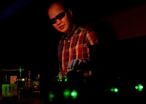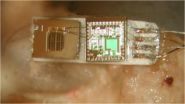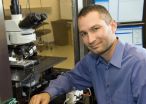(Press-News.org) PROVIDENCE, R.I. [Brown University] — Red, green, and blue lasers have become small and cheap enough to find their way into products ranging from BluRay DVD players to fancy pens, but each color is made with different semiconductor materials and by elaborate crystal growth processes. A new prototype technology demonstrates all three of those colors coming from one material. That could open the door to making products, such as high-performance digital displays, that employ a variety of laser colors all at once.
"Today in order to create a laser display with arbitrary colors, from white to shades of pink or teal, you'd need these three separate material systems to come together in the form of three distinct lasers that in no way shape or form would have anything in common," said Arto Nurmikko, professor of engineering at Brown University and senior author of a paper describing the innovation in the journal Nature Nanotechnology. "Now enter a class of materials called semiconductor quantum dots."
The materials in prototype lasers described in the paper are nanometer-sized semiconductor particles called colloidal quantum dots or nanocrystals with an inner core of cadmium and selenium alloy and a coating of zinc, cadmium, and sulfur alloy and a proprietary organic molecular glue. Chemists at QD Vision of Lexington, Mass., synthesize the nanocrystals using a wet chemistry process that allows them to precisely vary the nanocrystal size by varying the production time. Size is all that needs to change to produce different laser light colors: 4.2 nanometer cores produce red light, 3.2 nanometer ones emit green light and 2.5 nanometer ones shine blue. Different sizes would produce other colors along the spectrum.
The cladding and the nanocrystal structure are critical advances beyond previous attempts to make lasers with colloidal quantum dots, said lead author Cuong Dang, a senior research associate and nanophotonics laboratory manager in Nurmikko's group at Brown. Because of their improved quantum mechanical and electrical performance, he said, the coated pyramids require 10 times less pulsed energy or 1,000 times less power to produce laser light than previous attempts at the technology.
Quantum nail polish
When chemists at QDVision brew a batch of colloidal quantum dots for Brown-designed specifications, Dang and Nurmikko get a vial of a viscous liquid that Nurmikko said somewhat resembles nail polish. To make a laser, Dang coats a square of glass — or a variety of other shapes — with the liquid. When the liquid evaporates, what's left on the glass are several densely packed solid, highly ordered layers of the nanocrystals. By sandwiching that glass between two specially prepared mirrors, Dang creates one of the most challenging laser structures, called a vertical-cavity surface-emitting laser. The Brown-led team was the first to make a working VCSEL with colloidal quantum dots.
The nanocrystals' outer coating alloy of zinc, cadmium, sulfur and that molecular glue is important because it reduces an excited electronic state requirement for lasing and protects the nanocrystals from a kind of crosstalk that makes it hard to produce laser light, Nurmikko said. Every batch of colloidal quantum dots has a few defective ones, but normally just a few are enough to interfere with light amplification.
Faced with a high excited electronic state requirement and destructive crosstalk in a densely packed layer, previous groups have needed to pump their dots with a lot of power to push them past a higher threshold for producing light amplification, a core element of any laser. Pumping them intensely, however, gives rise to another problem: an excess of excited electronic states called excitons. When there are too many of these excitons among the quantum dots, energy that could be producing light is instead more likely to be lost as heat, mostly through a phenomenon known as the Auger process.
The nanocrystals' structure and outer cladding reduces destructive crosstalk and lowers the energy needed to get the quantum dots to shine. That reduces the energy required to pump the quantum dot laser and significantly reduces the likelihood of exceeding the level of excitons at which the Auger process drains energy away. In addition, a benefit of the new approach's structure is that the dots can act more quickly, releasing light before Auger process can get started, even in the rare cases when it still does start.
"We have managed to show that it's possible to create not only light, but laser light," Nurmikko said. "In principle, we now have some benefits: using the same chemistry for all colors, producing lasers in a very inexpensive way, relatively speaking, and the ability to apply them to all kinds of surfaces regardless of shape. That makes possible all kinds of device configurations for the future."
INFORMATION:
In addition to Nurmikko and Dang, another author at Brown is Joonhee Lee. QD Vision authors include Craig Breen, Jonathan Steckel, and Seth Coe-Sullivan, a company co-founder who studied engineering at Brown as an undergraduate.
The US. Department of Energy, the Air Force Office for Scientific Research, and the National Science Foundation supported the research. Dang is a Vietnam Education Foundation (VEF) Scholar.
Single nanomaterial yields many laser colors
Applications may include displays
2012-04-30
ELSE PRESS RELEASES FROM THIS DATE:
2 drugs better than 1 to treat youth with type 2 diabetes
2012-04-30
A combination of two diabetes drugs, metformin and rosiglitazone, was more effective in treating youth with recent-onset type 2 diabetes than metformin alone, a study funded by the National Institutes of Health (NIH) has found. Adding an intensive lifestyle intervention to metformin provided no more benefit than metformin therapy alone.
The study also found that metformin therapy alone was not an effective treatment for many of these youth. In fact, metformin had a much higher failure rate in study participants than has been reported in studies of adults treated with ...
Bioluminescent technology for easy tracking of GMO
2012-04-30
It is important to be able to monitor genetically modified (GM) crops, not only in the field but also during the food processing chain. New research published in BioMed Central's open access journal BMC Biotechnology shows that products from genetically modified crops can be identified at low concentration, using bioluminescent real time reporter (BART) technology and loop mediated isothermal amplification (LAMP). The combination of these techniques was able to recognise 0.1% GM contamination of maize, far below the current EU limit of 0.9%.
In agriculture GM crops have ...
Orangutans harbor ancient primate Alu
2012-04-30
Alu elements infiltrated the ancestral primate genome about 65 million years ago. Once gained an Alu element is rarely lost so comparison of Alu between species can be used to map primate evolution and diversity. New research published in BioMed Central's open access journal Mobile DNA has found a single Alu, which appears to be an ancestral great ape Alu, that has uniquely multiplied within the orangutan genome.
Analysis of DNA sequences has found over a million Alu elements within each primate genome, many of which are species specific: 5,000 are unique to humans, ...
Breastfeeding is associated with a healthy infant gut
2012-04-30
Early colonization of the gut by microbes in infants is critical for development of their intestinal tract and in immune development. A new study, published in BioMed Central's open access journal Genome Biology, shows that differences in bacterial colonization of formula-fed and breast-fed babies leads to changes in the infant's expression of genes involved in the immune system, and in defense against pathogens.
The health of individuals can be influenced by the diversity of microbes colonizing the gut, and microbial colonization can be especially important in regulating ...
A middle-ear microphone
2012-04-30
SALT LAKE CITY, April 30, 2012 – Cochlear implants have restored basic hearing to some 220,000 deaf people, yet a microphone and related electronics must be worn outside the head, raising reliability issues, preventing patients from swimming and creating social stigma.
Now, a University of Utah engineer and colleagues in Ohio have developed a tiny prototype microphone that can be implanted in the middle ear to avoid such problems.
The proof-of-concept device has been successfully tested in the ear canals of four cadavers, the researchers report in a study just published ...
Yellowstone 'super-eruption' less super, more frequent than thought
2012-04-30
PULLMAN, Wash.— The Yellowstone "super-volcano" is a little less super—but more active—than previously thought.
Researchers at Washington State University and the Scottish Universities Environmental Research Centre say the biggest Yellowstone eruption, which created the 2 million year old Huckleberry Ridge deposit, was actually two different eruptions at least 6,000 years apart.
Their results paint a new picture of a more active volcano than previously thought and can help recalibrate the likelihood of another big eruption in the future. Before the researchers split ...
Gladstone scientists identify brain circuitry associated with addictive, depressive behaviors
2012-04-30
SAN FRANCISCO, CA—April 29, 2012—Scientists at the Gladstone Institutes have determined how specific circuitry in the brain controls not only body movement but also motivation and learning, providing new insight into neurodegenerative disorders such as Parkinson's disease—and psychiatric disorders such as addiction and depression.
Previously, researchers in the laboratory of Gladstone Investigator Anatol Kreitzer, PhD, discovered how an imbalance in the activity of a specific category of brain cells is linked to Parkinson's. Now, in a paper published online today in Nature ...
Tablet-based case conferences improve resident learning
2012-04-30
Tablet based conference mirroring is giving residents an up close and personal look at images and making radiology case conferences a more interactive learning experience, a new study shows.
Residents at Northwestern University in Chicago are using tablets and a free screen sharing software during case conferences to see and manipulate the images that are being presented.
"The idea stems from the fact that I was used to having presentation slides directly in front of me during medical school lectures. I thought this would benefit radiology residents, especially in ...
MR enterography is as good or better than standard imaging exams for pediatric Crohn's patients
2012-04-30
MR enterography is superior to CT enterography in diagnosing fibrosis in pediatric patients with Crohn disease and equally as good as CT enterography in detecting active inflammation, and a new study shows.
The study, conducted at Massachusetts General Hospital in Boston, found that MR enterography was 77.6% accurate in depicting fibrosis compared to 56.9% for CT enterography. MR enterography had an 82.1% accuracy rate versus 77.6% accuracy rate for CT enterography for detecting active inflammation, said Keith Quencer, MD, one of the authors of the study. The study ...
Radiologists rank themselves as less than competent on health policy issues
2012-04-30
Radiologists classify themselves as less competent than other physicians regarding knowledge of patient imaging costs and patient safety, a new study shows.
The study conducted at Thomas Jefferson University in Philadelphia and Northwestern University in Chicago compared 711 radiologists to 2,685 non-radiology physicians. "On a scale of one to five, with five being highly competent, understanding of patient safety was rated as 3.1 by radiologists and 3.33 by non-radiologists," said Rajni Natesan, MD, an author of the study from Northwestern University. Patient imaging ...
LAST 30 PRESS RELEASES:
The Ceramic Society of Japan’s Oxoate Ceramics Research Association launches new international book project
Heart-brain connection: international study reveals the role of the vagus nerve in keeping the heart young
Researchers identify Rb1 as a predictive biomarker for a new therapeutic strategy in some breast cancers
Survey reveals ethical gaps slowing AI adoption in pediatric surgery
Stimulant ADHD medications work differently than thought
AI overestimates how smart people are, according to HSE economists
HSE researchers create genome-wide map of quadruplexes
Scientists boost cell "powerhouses" to burn more calories
Automatic label checking: The missing step in making reliable medical AI
Low daily alcohol intake linked to 50% heightened mouth cancer risk in India
American Meteorological Society announces Rick Spinrad as 2026 President-Elect
Biomass-based carbon capture spotlighted in newly released global climate webinar recording
Illuminating invisible nano pollutants: advanced bioimaging tracks the full journey of emerging nanoscale contaminants in living systems
How does age affect recovery from spinal cord injury?
Novel AI tool offers prognosis for patients with head and neck cancer
Fathers’ microplastic exposure tied to their children’s metabolic problems
Research validates laboratory model for studying high-grade serous ovarian cancer
SIR 2026 delivers transformative breakthroughs in minimally invasive medicine to improve patient care
Stem Cell Reports most downloaded papers of 2025 highlight the breadth and impact of stem cell research
Oxford-led study estimates NHS spends around 3% of its primary and secondary care budget on the health impacts of heat and cold in England
A researcher’s long quest leads to a smart composite breakthrough
Urban wild bees act as “microbial sensors” of city health.
New study finds where you live affects recovery after a hip fracture
Forecasting the impact of fully automated vehicle adoption on US road traffic injuries
Alcohol-related hospitalizations from 2016 to 2022
Semaglutide and hospitalizations in patients with obesity and established cardiovascular disease
Researchers ‘listen in’ to embryo-mother interactions during implantation using a culture system replicating the womb lining
How changing your diet could help save the world
How to make AI truly scalable and reliable for real-time traffic assignment?
Beyond fragmented markets: A new framework for efficient and stable ride-pooling
[Press-News.org] Single nanomaterial yields many laser colorsApplications may include displays


